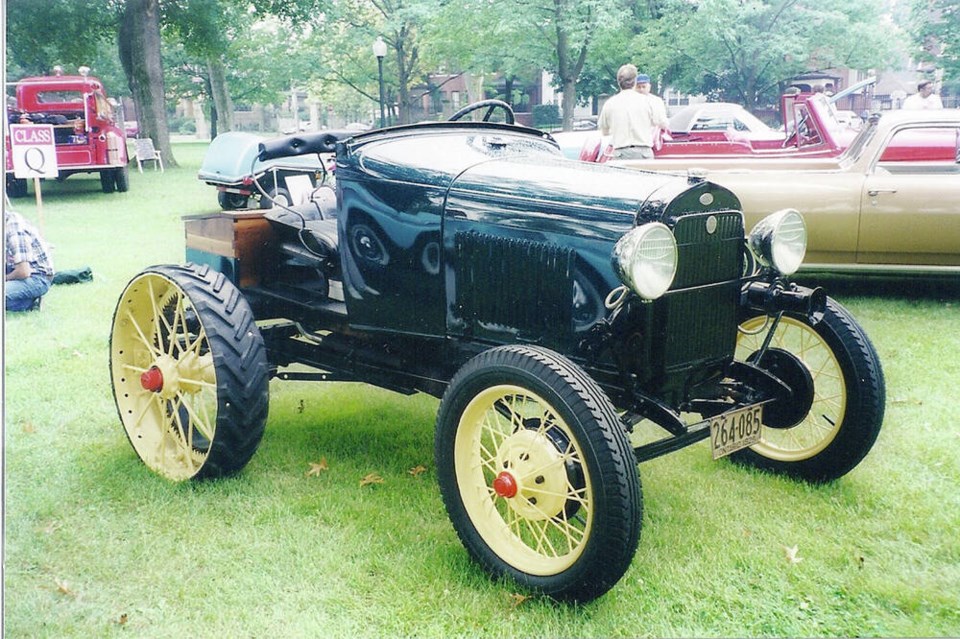The farm tractor has contributed immeasurably to agricultural mechanization. It dates from 1902 when Charles Hart and Charles Parr of Charles City, Iowa made their first production Hart-Parr tractor.
There were already large, steam powered “road locomotives” in use, but while suitable for threshing and other belt work, they were too large and cumbersome for general farm use. They also required a fairly skilled operator.
The Hart-Parr was designed to be a more convenient size for a farm, and tractors gradually began replacing horses,
a trend that accelerated following the 1917 introduction of the Fordson tractor. Henry Ford hoped to do for farming what his ubiquitous Model T car had done for road travel.
While tractors were becoming popular not all farmers could afford them. For those of more modest means or smaller acreages there evolved an aftermarket solution: kits that converted automobiles no longer used for transportation into traction machines.
One type was a kit that could be attached to a car, but left the car intact. As the Ford Model T was the world’s most popular car during the early part of the twentieth century it attracted many such kits. It is estimated that between 1908 and 1917 more than 40 U.S. companies offered Model T-auto-traction conversions.
These included the Auto Pull Company of Glencoe, Minnesota (“Does the work of four or five horses at the cost of one”), and the Pullford Company of Quincy, Illinois. Conversion usually involved fitting large, cleated rims over the car’s rear wheels, and some form of reduction gear. An auxiliary cooling fan was usually fitted to prevent engine overheating.
Removing the kit returned the Model T to a road car with the Auto Pull Company claiming that a T could be converted to a tractor in 10 minutes, and back to a car in five. Pullford said their conversion took 30 minutes.
A more satisfactory and somewhat later solution was a machine called the autotrac, a kind of “poor man’s tractor” that was half car and half tractor. It gradually gained in popularity, which accelerated during the Second World War when regular tractors were scarce.
An autotrac was built using an old car and prefabricated parts, and once a car was converted there was no going back. The autotrac was constructed by removing the passenger cabin, cutting off the back part of the car’s frame ahead of the rear axle and replacing it with the commercially available kit. The wheelbase was usually shortened for better manoeuvrability and operator access to implements.
These kits would fit a variety of cars built up to the early 1930s, cars that were still sitting around because their road-going days were over.
The main elements of the kit were a frame with a drawbar and large steel-cleated or rubber-clad tractor wheels with large ring gears fitted just inside the rims. Steel pinions were attached to the car’s axles which engaged with the wheels’ ring gears.
The conversion kits could be installed by a local garage or blacksmith shop, or a skilled farmer with the instructions supplied.
Several companies including the Sears Roebuck mail order house in Chicago offered autotrac kits. The Sears kit was designed for Ford Models T and A and Chevrolets. The Worthington Company of Stroudsburg, Pennsylvania, sold assembled Ford-based autotracs, also referred to as doodlebugs.
A major Canadian manufacturer of autotrac kits was the OTACO company of Orillia, Ontario. The OTACO name was an acronym for the Orillia Tudhope Anderson Company that had been formed in 1902 to market wagons and farm implements produced by the Tudhope Carriage Company. The Tudhope Motor Car Co. would later manufacture automobiles of both high-wheel and conventional design.
The OTACO autotrac kit was based on a design being built by the Pullford Company of Rockford, Illinois (presumably the aforementioned Quincy, Ill. company, now relocated).
When OTACO representatives visited the principals of Pullford to inquire about manufacturing the kits in sa国际传媒 they were apparently told that if they bought a kit they could go ahead and begin making them with no royalties. Such generosity would be highly unusual today.
OTACO began manufacturing autotrac kits during the Second World War, and by the time they stopped making them in the early 1960s more than 6,000 had been produced. They were sold in sa国际传媒 and the U.S. and served farmers well.
Although the OTACO kits were intended to fit all older cars such as Plymouths, Chevrolets, Whippets and Stars, the most popular base for autotracs was the 1928- 1931 Model A Ford. They were sturdy, simple and plentiful and parts were readily available, all good reasons for using them.
Autotracs are little remembered now, but they played an important role in agriculture. Thankfully there are still enthusiasts collecting and restoring them to keep alive memories of simpler days.



